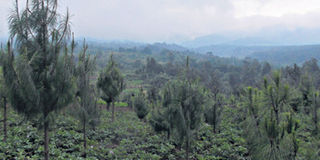In search of a rare viper

Rupi Mangat braves the cold and rain to look for a rare viper found only in the Aberdare ranges. PHOTO| RUPI MANGAT
What you need to know:
The hike begins from the station – Kaburu – so called, I suppose, because there must have been quite a few mzungus around before independence.
There’s even a school from that time – a single block of classrooms complete with blackboards but now in disrepair and turned into cow-sheds.
The kids must have had a surreal view of the mountain.
I have a love-hate relationship with climbing mountains; scaling uphill is hard work, but reaching heights is awesome.
On this cold, grey morning, we’re at the southern-end of the 150-kilometre-long Aberdares, that was first described in 1884 by Joseph Thomson while on an expedition in search of the most direct route through the interior to Lake Victoria.
The 90-kilometre-drive past the Great Rift Valley, turning into Njabini and finally to Kaburu Forest Station is mist-filled, with Longonot invisible in the valley. The only time the sun appears is when we’re close to the mountain waiting for the vehicles stuck in the mud to be pushed out. The diversion created while the new road is being tarmacked is causing mayhem with the traffic. I take a quick snapshot of Elephant Hill. It takes some imagination to see the elephant in the hill.
At first I’m daunted by my fellow-climbers: women with bodies designed for scaling, and sturdy men. I take heart when I see little Franco Ogada in tow – I think I can keep up with him, and with the few birders stopping every time they spot birds of the mountains.
THE HIKE BEGINS...
The hike begins from the station – Kaburu – so called, I suppose, because there must have been quite a few mzungus around before independence.
There’s even a school from that time – a single block of classrooms complete with blackboards but now in disrepair and turned into cow-sheds. The kids must have had a surreal view of the mountain.
At first it’s easy along the red-murram road straddling the plantation forest. Newly planted trees tower the potatoes with their quaint lilac flowers. The highland birds are a-twitter, including the Hartlaub’s turaco, a stunning forest bird with a brilliant scarlet under wing, and the rare Hunter’s cisticola. The birders are enchanted with a trio of Augur buzzards on a branch. They are stunning at close quarters.
I’m hoping to spot a tiny green snake that’s one of the most difficult to see and rarely recorded – the Montane viper. It’s about the length of a soda-bottle, and comes out of the thick grasses to sun itself. The slightest vibration in the ground has it slithering back to its cover (snakes are deaf and only feel vibrations in the ground). My eyes are pretty much glued to the ground – and it’s beginning to get colder and to drizzle.
Then the skies open, and it’s a long, wet and muddy walk – slithering and falling – back to base. There’s not a chance in a million that the Montane viper would even take a peek from its cover in this weather. I’ll just have to brave the mountain again if I want to see it.
Fact File
The Aberdare Range forms a rim of the Great Rift Valley and Kinangop plateau famous for its endemic Sharpe’s Longclaw. The range has a maximum 13,120 ft above sea level
It is one of Kenya five water towers and without it, Nairobi would have no water. It’s water catchment area for the Sasumua dam and the Ndakaini dam, and the mountain forests are catchment areas for Tana, Kenya’s longest river.
Dedan Kimathi, Kenya’s famous freedom fighter used the massifs as his headquarters and Elizabeth II became Queen of the United Kingdom while on holiday at the Treetops Lodge in the Aberdares.




